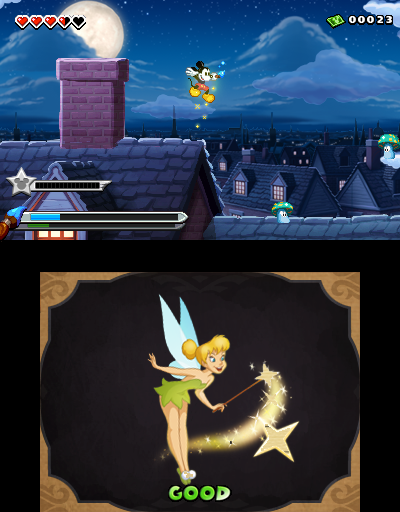Gorgeous sprites and backgrounds; entertaining platforming; great controls; devilish design; and the RPG-lite Fortress
A creative yet flawed painting and erasing mechanic; inconsistent pacing; too few levels and bosses
Epic Mickey: Power of Illusion starts off on the wrong foot with a dull and long cut-scene to set the story. Once the screen finally fades to developer DreamRift’s beautiful sprites and backgrounds and the action takes place, the game begins to hit its stride — but not without some missteps along the way.
DreamRift, which created Monster Tale and is known for creative use of dual-screen gaming, paints a gorgeous 2D platforming setting for Power of Illusion. Mickey’s sprite bounces and bounds with fluidity against the backdrop of multilayered castles and vistas based on “Peter Pan,” “Aladdin” and “The Little Mermaid”. The 3D stereoscopic effect further enhances the visuals, providing a real treat for the eyes. Further complementing the presentation is the orchestral score, which transfers over with relative success from its big-console brethren.
Mickey controls like a dream, although he moves at his own steady pace. Paint and thinner play an important role, serving as projectiles as well as the title’s novel use of the dual screens. With the touch screen, players draw and erase objects that interact with the top screen. If there’s a pesky cannon spouting out cannonballs, gamers can erase the item and move along carefree.
This dual-screen element sounds difficult on paper but works easily enough in execution. To create an object, just trace along a provided outline. To erase the item, merely scribble it out with the stylus. Time as well as paint and thinner resources add a bit of depth to this mechanic, but overall, this concept falls flat. While technically sound, the act of drawing and erasing hampers the pacing of the already slower-natured game. Each creation or deletion results in an animation that takes about 10 to 15 seconds, which sounds trivial, but grows annoying after the first hour.
The creative concept doesn’t quite flow well with the platforming gameplay, which leads to player neglect unless an action is absolutely necessary for level progression. However, boss battles — of which there are only three — cleverly utilize the mechanic and demonstrate the high points of the idea.

The more accurately the player can copy the outline of the objects on to the bottom screen, the more useful the objects will become in gameplay. To read more about this feature, check out our preview of the game!
The core platforming elements, though, are strong and entertaining. Mickey can butt-bounce enemies, shoot projectiles with paint and thinner, spin attack, and even utilize eight different sketches to tackle foes and navigate environments. DreamRift showcases its design prowess within each level, crafting branching stages with devilish enemy placement. This stands out because the developer hides boundless secrets and Disney characters, which usually rely on smartly disposing of baddies. For instance, butt bouncing provides a super jump with proper timing, and killing an adversary before realizing their purpose as a platform or otherwise can lead to regret. There is challenge and reward within Power of Illusion, especially while scavenging for every little treasure.
But the Disney characters are not just treasures to seek. They actually serve as the foundation for the Fortress, which works as a mini-RPG. The 20-plus cartoon icons — including Uncle Scrooge, Rapunzel, Simba and Alice — dish out quests for Mickey, making him draw items or revisit past locations for their lost goods. Each character also inhabits their own room that Mickey upgrades along the way. But this is not just window dressing, as the Fortress also is somewhat integral to world progression. Players must advance a bit in the Fortress — finding characters and completing a couple of quests — to open up the next area. Thankfully, finished tasks also reward Mickey with new upgrades, such as faster projectiles or health upgrades. These RPG-lite aspects become addictive for OCD players, but this integrated mode also feels like padding in some ways. Power of Illusion features only 11 levels, and the quests expand the playtime with revisiting stages. As such, this mode really teeters between fun extra depth and an excuse to elongate the game.
While DreamRift misses the mark with the painting and erasing mechanic, the creative concept is a bold attempt at utilizing both screens. Epic Mickey: Power of Illusion looks great and controls well, boasting some inspiring Disney stages, but there just aren’t enough of them. Overall, the title struggles to find its stride but also possesses a unique charm that demands attention.
Nintendojo was provided a copy of this game for review by a third party, though that does not affect our recommendation. For every review, Nintendojo uses a standard criteria.




 ShareThis
ShareThis







I have to admit, I expected more from DreamRift. Henry Hatsworth and Monster Tale were two of my favorite DS games as well as the reason for blindly pre-ordering Power of Illusion quite a while ago. It’ll still be enjoyable, for sure, but the paint mechanic that constantly halts gameplay (which was evident in the demo) and the lack of levels worries me.